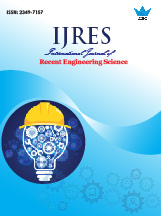Tuning of a Feedback Lag-Lead First-Order Compensator used with a Fractional Time Delay Double Integrating Process
 |
International Journal of Recent Engineering Science (IJRES) |  |
| © 2015 by IJRES Journal | ||
| Volume-2 Issue-2 |
||
| Year of Publication : 2015 | ||
| Authors : Galal Ali Hassaan |
||
| DOI : 10.14445/23497157/IJRES-V2I2P101 |
How to Cite?
Galal Ali Hassaan, "Tuning of a Feedback Lag-Lead First-Order Compensator used with a Fractional Time Delay Double Integrating Process,"International Journal of Recent Engineering Science, vol. 2, no. 2, pp. 1-5, 2015. Crossref, https://doi.org/10.14445/23497157/IJRES-V2I2P101
Abstract
The problem of controlling an unstable delayed double integrating process using a feedback first-order lag-lead compensator is studied. The effect of time delay of the process in a range between 0.1 and 0.8 seconds is considered. The compensator is tuned using MATLAB optimization toolbox with five forms of the objective function in terms of the error between the step time response of the closed-loop control system and the response steady-state value. Using the proposed compensator with the delayed double integrating process indicates the robustness of the compensator in the time delay range used with superior time-based specifications. The dynamics of the control system are compared with other technique based on using a feedforward first-order lag-lead compensator.
Keywords
Feedback first-order lag-lead compensator , Fractional delayed double integrating process, Compensator tuning, Control system performance, Compensator robustness.
Reference
[1] W. Zhang, Modified Smith predictor for controlling integrator/time delay processes, Industrial Engineering and Chemical Research , 35(8),1996, 2769-2772.
[2] A. O'Dwyer, A survey of techniques for the estimation and compensation of processes with time delay, Technical Report No. AOD,00.03, 17 May 2000, Dublin Institute of Technology, Ireland.
[3] S. Skogestad, Simple analytic rules for model reduction and PID controller tuning, , Modeling, Identification and Control, 25(2), 2004, 85-120.
[4] A. Rao and M. Childambaram, Enhanced two-degree of freedom control strategy for second-order unstable processes with time delay, Industrial Engineering and Chemical Research, 45(10), 2006, 3604-3614.
[5] A. Rao, V. Rao and M. Childambaram, Simple analytical design of modified Smith predictor with improved performance for unstable first-order plus time delay processes, , Industrial Engineering and Chemical Research, 46(13), 2007, 4561-4571.
[6] P. Garcia and P. Albertos, A new dead-time compensator to control stable and integrating processes with long dead-time, , Automatica, 44(4), 2008, 1062-1071.
[7] S. Alcantara , Analytical design of feedback compensator based on robustness/performance and servo/regulator trade offs, Ph.D. Thesis, Universitat Autonome de Barcelona, July 2011.
[8] Z. Nie, Q. Wang, M. Wa, Y. He and Q. Qin, Lead/lag compensator design for unstable delay proceses based on new gain and phase margin specifications, Industrial Engineering and Chemical Research , 50(3),2011, 1330-1337.
[9] G. A. Hassaan, M. Al-Gamil and M. Lashin, Tuning of a laglead compensator used with a first-order plus an integrator process, International Journal of Mechanical and Production Engineering Research and Development, 3(5), 2013, 41-48.
[10] V. Hassani, T. Tjahowidodo and T. Do, A survey on hysteresis modeling, identification and control, Mechanical Systems and Signal Processing, 49, 2014, 209-233.
[11] G. A. Hassaan, Tuning of a first-order lag-lead compensator used with a simple pole plus double integrator process, International Journal of Advanced Research in Computer Science and Technology, 2(4), 2014, 17-20.
[12] G. A. Hassaan, Robustness of feedback first-order lag-lead, feedforward second-order lag-lead and feedforward firstorder lag-lead compensators used with second-order processes, , International Journal of Advances in Engineering and Technology, 7(6), 2015, 1711-1720.
[13] S. Skogestad and C. Grimholt,
[14] K. Ogata, Modern control engineering (Pearson Education Int., 2010).
[15] G. A. Hassaan, Tuning of a first-order lag-lead compensator used with very slow second-order process, International Journal of Advances in Engineering and Technology, 7(4), 2015, 1786-1791.
[16] P. Venkataraman, Applied optimization with MATLAB programming (J. Wiley & Sons, 2009).
[17] F. Martins, Tuning PID controllers using the ITAE criterion, International Journal of the Engineering Education, 21(5), 2005, 867-873.
[18] C. Calistru and P. Georgescu, Tuning of PID robust controllers based on ISE criterion minimization, 7th International Conference on Electro-mechanical and Power Systems, Iasi, Romania, October 8-9, 2009, I-30 to I-35.
[19] S. Cheng and C. Hwang, Designing PID controllers with a minimum IAE criterion by a differential evolution algorithm, Chemical Engineering Communications, 170(1), 1998, 83-115.
[20] A. Marzoughi, H. Salamat, M. Rahmat and H. AbdulRahim, Optimized PID controller for the exhaust temperature control of a gas turbine system using particle swarm optimization, International Journal of the Physical Sciences, 7(5), 2012, 720-729.
[21] R. Dukkipati, Analysis and design of control systems using MATLAB (New Age International Publishers, 2006).
[22] G. A. Hassaan, Tuning of a feedforward lag-lead forst-order compensator used with a fractional time delay double integrating process, International Journal of Engineering and Technology, 2015 (under publication).
